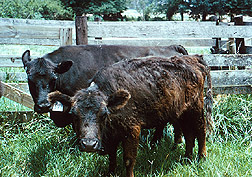This page has been archived and is being provided for reference purposes only. The page is no longer being updated, and therefore, links on the page may be invalid.
Connecting the Dots for Alkaloids, Toxicosis Symptoms
By Laura McGinnisJune 29, 2009
New research from Agricultural Research Service (ARS) scientists and their university colleagues is shedding light on the relationship between chemical compounds and fescue toxicosis—a disease that affects grazing animals and costs the U.S. cattle industry an estimated $600 million annually.
Fescue toxicosis is a major problem for producers whose herds graze on tall fescue. A major forage grass in many states, tall fescue can cause toxicosis in cattle and other ruminants if it's infected with endophytic fungus. The disease causes lameness and reduced production efficiency, and can even be fatal if infected animals are subjected to stressful situations, such as extreme heat or long-distance transport.
Scientists believe many symptoms of toxicosis are caused by chemical compounds known as ergot alkaloids, but much is still unknown about how they cause clinical signs to develop. Led by ARS animal scientist James Klotz, scientists at the ARS Forage Animal Production Research Unit in Lexington, Ky., and the University of Kentucky are investigating the physiological responses of ruminants to tall fescue alkaloids.
One sign of toxicosis is a narrowing of blood vessels. Using a model that predicts changes in blood flow in the limbs of cattle, Klotz and his colleagues examined the influence of specific alkaloids—both individually and in combination.
Of the three alkaloids tested, ergovaline was the most effective at making the veins contract. The others, N-acetylloline and lysergic acid, had little effect on vein contraction. The results also showed that combining two alkaloids did not increase the toxicity of either—at least in terms of vein contraction.
Further research is underway to determine how these alkaloids influence other tissues, organs and physiological systems. In one study, the scientists showed that ergovaline, but not lysergic acid, can bioaccumulate in vitro, suggesting that ergovaline may be more likely to induce toxicosis.
Research like this is essential for understanding exactly how endophyte-infected tall fescue influences grazing animals. Eventually, this information could help scientists determine which compounds are most toxic and how to protect cattle from them.
These studies were published in the Journal of Animal Science.
ARS is the principal intramural scientific research agency for the U.S. Department of Agriculture.

